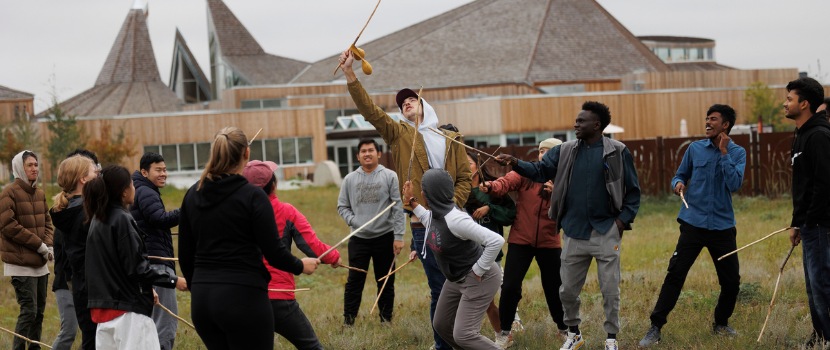SASKATOON — Saskatchewan Polytechnic Recreation and Tourism Management first-year students experienced Indigenous culture through interactive activities during a culture camp at Wanuskewin Heritage Park on September 11 and 12.
Amy Peters, Diversity and Cultural Foundations instructor explains it’s important for students to learn about Indigenous culture early in the program, as it sets the bar for the year. The culture camp at Wanuskewin introduced the students to traditional techniques to prepare fish and hides. They also played games like double ball, a skills and endurance-based game by Plains First Nations, which has influenced modern sports.
Misty Ledoux, representative workforce consultant at Sask Polytech, facilitated a smudging and a Kairos Blanket Exercise to teach participants about Indigenous rights history.
“It’s an interactive activity where you’re walking in the shoes of Indigenous people. It’s different from a lecture in a classroom or from reading a book because students interact with one another. It can be a really emotional experience for students. There’s a debrief after the blanket exercise. We have a lot of good discussion and there’s a lot of sharing. The students appreciate other people’s perspectives,” she notes.
With the Truth and Reconciliation Commission 94 Calls to Action in mind, the practical experiences at Wanuskewin help students gain a better understanding of Indigenous realities, traditions and inclusion.
“When you talk about reconciliation, you have to understand the why. For Indigenous people, the land is so important, it’s tied to 小蓝视频, history and language. Having this understanding helps students be better at the jobs they get after graduation,” adds Ledoux.
Says Peters, “My goal is to always balance enjoyable experiences to help us remember Indigenous culture is alive while honouring and recognizing Indigenous history. It’s important for everyone living here to know the context of where they live. We have a lot of international students and it's new information for them.”
After the camp students continued their learning with the 4 Seasons of Reconciliation course to learn about the history and culture of Indigenous communities across Canada, including the history of residential schools and treaties. Peters notes it’s an intentional way to prepare students for the National Day for Truth and Reconciliation.
“I hope this sets them up to really understand what September 30 is about. My hope is that having this lived experience is something that encourages us to look at how we continue working on the call to actions and how we continue to move forward.”
The Diversity and Cultural Foundations class has learning outcomes based on various cultures while looking at inequalities to prepare students for careers as recreational programmers, tour guides, tourism leaders or workers in the non-profit sector for community development. For student Stephanie Ritchie, the experience of culture camp helped her gain a deeper understanding of Indigenous communities around her.
“We heard Indigenous stories. We participated in a smudging. I had never done that before. Day two really opened my eyes. We stepped into the shoes of Indigenous people, so it was different than learning about Indigenous history in a classroom,” she explains before adding, “I love travelling. I spent the last two years travelling and taking in cultures. I realized I didn’t know a lot about the culture around me. With truth and reconciliation, it’s important that we remember and fully understand what happened in the past and see how we can help.”
Recreation and Tourism Management students will continue to visit Wanuskewin weekly throughout their two-year diploma program. They have access to applied learning and experiences at the site, which aren’t available in a classroom setting. The next event will have second-year students run some outdoor activities for first-year students. The day will begin with a land acknowledgement led by second-year students. This is an opportunity for second-year students to put elements they have learned into practice.
Throughout the rest of the first semester, time spent at Wanuskewin will enable first-year students to gain a better understanding of Indigenous perspectives on health, wellness and ceremonies. These exchanges are vital to students and instructors alike.
“I work here in recreation and tourism because I have a strong belief in bringing people together. This is how we break down barriers, by enjoying time together,” says Peters.
Learn more about Sask Polytech’s .
— Submitted by Saskatchewan Polytechnic
SASKTODAY.ca is Saskatchewan's home page. Bookmark us at this link




